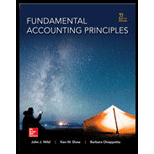
Debit Card:
It is a type of card issued for making payments and the amount gets deducted from the payer’s account itself, thus eliminates the use of cash as well as cheques in order to make payments and thus provides convenience to its holders. Also, a particular limit is specified for overdraft coverage to help customers when they fall short of funds apart from the amount they actually have in their account balances. In addition to this, they have daily limits for the amounts to be utilized through them.
Credit Card:
Credit card is issued to give option to the holders to borrow funds at a specified point-of-sale. These are used for financing in short term and charge interest. Generally, interest is charged after one month after purchase and borrowings limits are based upon individual credit ratings.
To explain: The way of deriving benefits from customers in lieu of allowing them to use credit cards
Explanation of Solution
The credit card issuers earn profits by allowing the customers to use it in the following manner:
• Whenever the holder makes payment by using his or her credit card a certain percentage of purchases made through the card gets accumulated in interchange fees and most of the amount goes to the issuing bank and the other part is for the party managing the credit card account.
• The fees collected by the credit card issuers including annual fees, late fees, and balance transfer fees and other similar services.
• Interest payments pool in lot of revenue for the credit card issuers especially in the cases of non-payment.
• The issuers also earn profits as sales commission on account of selling customer data to other business entities.
Hence, the credit card issuers earn many benefits by allowing the customers to utilize the credit card facilities.
Want to see more full solutions like this?
Chapter 9 Solutions
Fundamental Accounting Principles -Hardcover
- Can you explain the correct approach to solve this general accounting question?arrow_forwardI am searching for the accurate solution to this general accounting problem with the right approach.arrow_forwardI am trying to find the accurate solution to this general accounting problem with the correct explanation.arrow_forward
- Please help me solve this general accounting problem with the correct financial process.arrow_forwardI am looking for help with this general accounting question using proper accounting standards.arrow_forwardCan you solve this general accounting problem using appropriate accounting principles?arrow_forward

 AccountingAccountingISBN:9781337272094Author:WARREN, Carl S., Reeve, James M., Duchac, Jonathan E.Publisher:Cengage Learning,
AccountingAccountingISBN:9781337272094Author:WARREN, Carl S., Reeve, James M., Duchac, Jonathan E.Publisher:Cengage Learning, Accounting Information SystemsAccountingISBN:9781337619202Author:Hall, James A.Publisher:Cengage Learning,
Accounting Information SystemsAccountingISBN:9781337619202Author:Hall, James A.Publisher:Cengage Learning, Horngren's Cost Accounting: A Managerial Emphasis...AccountingISBN:9780134475585Author:Srikant M. Datar, Madhav V. RajanPublisher:PEARSON
Horngren's Cost Accounting: A Managerial Emphasis...AccountingISBN:9780134475585Author:Srikant M. Datar, Madhav V. RajanPublisher:PEARSON Intermediate AccountingAccountingISBN:9781259722660Author:J. David Spiceland, Mark W. Nelson, Wayne M ThomasPublisher:McGraw-Hill Education
Intermediate AccountingAccountingISBN:9781259722660Author:J. David Spiceland, Mark W. Nelson, Wayne M ThomasPublisher:McGraw-Hill Education Financial and Managerial AccountingAccountingISBN:9781259726705Author:John J Wild, Ken W. Shaw, Barbara Chiappetta Fundamental Accounting PrinciplesPublisher:McGraw-Hill Education
Financial and Managerial AccountingAccountingISBN:9781259726705Author:John J Wild, Ken W. Shaw, Barbara Chiappetta Fundamental Accounting PrinciplesPublisher:McGraw-Hill Education





